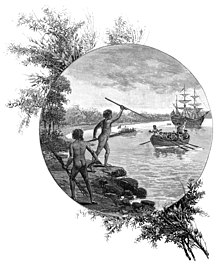
Back تاريخ الأستراليين الأصليين Arabic Historia dos indíxenas de Australia Galician História dos indígenas australianos Portuguese
| This article is part of a series on the |
| History of Australia |
|---|
 |
|
|
The history of Indigenous Australians began at least 65,000 years ago when humans first populated the Australian continental landmasses.[1] This article covers the history of Aboriginal Australian and Torres Strait Islander peoples, two broadly defined groups which each include other sub-groups defined by language and culture.
The origin of the first humans to populate the southern continent and the pieces of land which became islands as ice receded and sea levels rose remains a matter of conjecture and debate. Some anthropologists believe they could have arrived as a result of the earliest human migrations out of Africa. Although they likely migrated to the territory later named Australia through Southeast Asia, Aboriginal Australians are not demonstrably related to any known Asian or Melanesian population, although Torres Strait Islander people do have a genetic link to some Melanesian populations. There is evidence of genetic and linguistic interchange between Australians in the far north and the Austronesian peoples of modern-day New Guinea and the islands, but this may be the result of recent trade and intermarriage.[2]
Estimates of the number of people living in Australia at the time that colonisation began in 1788, who belonged to a range of diverse groups, vary from 300,000 to a million,[3] and upper estimates place the total population as high as 1.25 million.[4] A cumulative population of 1.6 billion people has been estimated to have lived in Australia over 65,000 years prior to British colonisation.[5] The regions of heaviest Aboriginal population were the same temperate coastal regions that are currently the most heavily populated, the Murray River valley in particular. The population shrank from those present when colonisation began in New South Wales in 1788, to 50,000 in 1930. This drastic reduction in numbers has been attributed to outbreaks of smallpox and other diseases,[6][7] but other sources have emphasised the extent of frontier clashes and in most cases, deliberate killings of Aboriginal peoples.[8]
Post-colonisation, the coastal Indigenous populations were soon absorbed, exterminated,[9] depleted or violently forced from their lands; the traditional aspects of Aboriginal life which remained persisted most strongly in areas such as the Great Sandy Desert where European settlement has been sparse. Although the Aboriginal Tasmanians were almost driven to extinction (and once thought to be so), other Aboriginal Australian peoples maintained successful communities throughout Australia.
- ^ Clarkson, Chris; Jacobs, Zenobia; Marwick, Ben; et al. (2017). "Human occupation of northern Australia by 65,000 years ago" (PDF). Nature. 547 (7663): 306–310. Bibcode:2017Natur.547..306C. doi:10.1038/nature22968. hdl:2440/107043. ISSN 0028-0836. PMID 28726833. S2CID 205257212.
- ^ Diamond, Jared (1997). Guns, Germs, and Steel. London: Random House. pp. 314–316.
- ^ "Colonisation: Initial invasion and colonisation (1788 to 1890)". Working with Indigenous Australians. Retrieved 27 August 2020.
- ^ Evans, R. (2007). A History of Queensland. Cambridge UK: Cambridge U. Press. pp. 10–12. ISBN 978-0-521-54539-6.
- ^ Gordon Briscoe; Len Smith, eds. (2002), "2. How many people had lived in Australia before it was annexed by the English in 1788?", The Aboriginal Population Revisited: 70,000 years to the present, Canberra, Aboriginal Studies Press
- ^ D. Hopkins, Princes and Peasants, Chicago, 1983, p. 207; Judy Campbell, Invisible Invaders: Smallpox and Other Diseases in Aboriginal Australia 1780–1880, Melbourne, 2002, pp. 10, 39–50
- ^ Smallpox Through History. Archived from the original on 29 October 2009.
- ^ Pascoe, Bruce (2007). Convincing Ground: Learning to Fall in Love with Your Country. Aboriginal Studies Press. ISBN 978-0-85575-549-2.
- ^ Calla Wahlquist (2018). "Evidence of 250 massacres of Indigenous Australians mapped". TheGuardian.com. Retrieved 6 April 2021.
© MMXXIII Rich X Search. We shall prevail. All rights reserved. Rich X Search